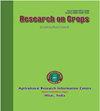Unveiling the efficacy of a bacterial antagonist in the management of tomato wilt disease caused by Ralstonia solanacearum
Q3 Agricultural and Biological Sciences
引用次数: 0
Abstract
The long-term application of agrochemicals, including pesticides, in intensive agricultural practices to protect crops from biotic stresses results in the emergence of resistance among phytopathogens and the ineffectiveness of chemical applications. The microbiological strategies, in contrast, minimize the reliance on chemicals and, hence, reduce environmental and human health risks. Bacterial wilt of tomato induced by Ralstonia solanacearum is one of the most destructive diseases worldwide that requires urgent attention to develop a safer and more efficient method to control the phytopathogen. The present work was conducted in the year 2022-2023. In this study, the bacterial wilt was managed by an antagonist bacterium, Pseudomonas fluorescens, exhibiting variable morphological, biochemical, and plant growth-promoting activities. The P. fluorescens inhibited the growth of R. solanacearum in plate assay at different time intervals (0-48 h). The SEM image of R. solanacearum cells cultured with P. fluorescens revealed pores, distortion, and fragmented cell envelope, while the untreated bacterial cells were uniform and smooth. Tomato plants infected with R. solanacearum showed 89% disease incidence compared to uninfected but PGPR-inoculated tomato plants. Application of P. fluorescens reduced disease incidence by 63% compared to R. solanacearum infested plants. Furthermore, plant length enhanced by 21 and 26% significantly following bacterial inoculation after three and four weeks of growth. Conclusively, this study emphasizes the effectiveness of using PGPR as a potent strategy for managing wilt disease in vegetable crops, especially tomato.揭示细菌拮抗剂在防治由茄黑僵菌(Ralstonia solanacearum)引起的番茄枯萎病中的功效
在集约化农业生产中长期使用农用化学品(包括杀虫剂)来保护作物免受生物胁迫,会导致植物病原体产生抗药性,并使化学品的使用失去效果。相比之下,微生物策略最大限度地减少了对化学品的依赖,从而降低了环境和人类健康风险。Ralstonia solanacearum 引发的番茄细菌性枯萎病是全球最具破坏性的病害之一,急需开发一种更安全、更有效的方法来控制这种植物病原体。本研究于 2022-2023 年进行。在这项研究中,细菌枯萎病由一种拮抗细菌--荧光假单胞菌(Pseudomonas fluorescens)控制,该细菌表现出不同的形态、生化和植物生长促进活性。在平板试验中,荧光假单胞菌在不同时间间隔(0-48 小时)抑制了茄枯萎病菌的生长。用 P. fluorescens 培养的 R. solanacearum 细胞的扫描电镜图像显示有孔隙、变形和破碎的细胞包膜,而未处理的细菌细胞则均匀、光滑。与未感染但接种了 PGPR 的番茄植株相比,感染了 R. solanacearum 的番茄植株的发病率为 89%。与受 R. solanacearum 感染的植株相比,施用 P. fluorescens 可使病害发生率降低 63%。此外,在番茄生长三周和四周后接种细菌,植株长度分别显著增加了 21% 和 26%。总之,这项研究强调了使用 PGPR 作为管理蔬菜作物(尤其是番茄)枯萎病的有效策略的有效性。
本文章由计算机程序翻译,如有差异,请以英文原文为准。
求助全文
约1分钟内获得全文
求助全文
来源期刊

Research on Crops
Agricultural and Biological Sciences-Soil Science
CiteScore
1.50
自引率
0.00%
发文量
93
审稿时长
1 months
期刊介绍:
The Research on Crops is a peer-reviewed journal publishing original research papers, review articles and short communications in English on all basic and applied aspects of crop sciences, agricultural water management, agro-climatology, agroforestry, agronomy, crop production, crop protection, cropping systems, food science & technology, genetics & plant breeding, horticulture, plant & soil science, plant biotechnology, plant nutrition, post-harvest management of crops, seed science, soil management & tillage, vegetables, weed science, agricultural engineering, agri-business, agricultural economics and extension, etc. The aim of the journal is to provide a forum for the scientific community to publish their latest research findings.
The manuscripts submitted for publication should not contain data older than 4 years on the date of submission.
The articles submitted for publication in this journal should not be submitted elsewhere simultaneously for publication in another journal. These should not carry any copyright material without prior permission of copyright holder.
The articles should present a complete picture of the investigation made and should not be split into parts.
There is no prescribed limit regarding the number of pages in case of full-length articles. However, the authors are advised to keep the length of their articles from 4 to 10 full printed pages of the journal.
The articles should be divided into the sub-sections: ABSTRACT, INTRODUCTION, MATERIALS AND METHODS, RESULTS AND DISCUSSION, CONCLUSIONS, and REFERENCES. Tables and figures should be appended separately at the end.
 求助内容:
求助内容: 应助结果提醒方式:
应助结果提醒方式:


